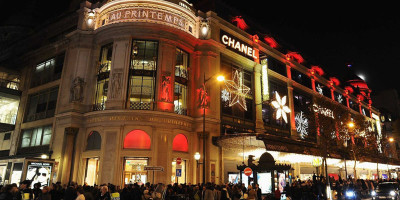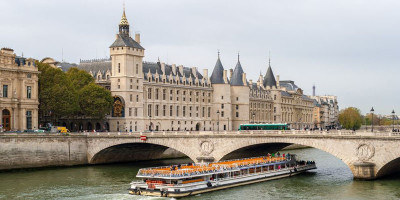
Lucky Luke and Jolly Jumper, seen in the entrance of the Belgian Comic Strip Center in Brussels. Photo by Spielvogel. Wikimedia Commons.
Top 10 Fun Facts about Belgian Comic Strip Center
The Belgian Comic Strip Center is a museum in Brussels, Belgium, dedicated to Belgian comics. It is located at 20, rue des Sables/Zandstraat, in an Art Nouveau building designed by Victor Horta, and can be accessed from Brussels-Congress railway station and Brussels Central Station.
As one of the few arts where Belgium has had an international and enduring impact in the 20th century, comics are known to be “an integral part of Belgian culture”. Belgian comics are a distinct subgroup in the comics history, and played a major role in the development of European comics. It is therefore no surprise that there is a whole space dedicated to comic strips. Let’s thereby look at the Top 10 Fun Facts about Belgian Comic Strip Center.
1. It was designed by architect Victor Horta

Photo by Ank Kumar. Wikimedia Commons.
The building was designed in 1905 by the world-famous architect Victor Horta, in Art Nouveau style, and served as a textile department store, the Magasins Waucquez.
After Waucquez’s death in 1920, the building began to languish away, and in 1970, the firm closed its doors. Jean Delhaye, a former aid of Horta, saved the building from demolition, and by 16 October 1975, it was designated as a protected monument. Still, the building was in bad shape and victim to a lot of vandalism.
2. The center was made a national property
In 1983, Belgian Minister of Public Works, Louis Olivier, decided that the building would be bought by the Direction of Buildings, making it national property.
In 1984, a fund was founded which brought together several Flemish and Walloon comics artists. Two years later, the restorations began, with respect for the original architecture, while updating it to modern standards.
3. The mosaic inside the center was done by Italians
The mosaics were flown over from Italy and constructed by Italian mosaic workers, because the profession had become obsolete in Belgium.
4. Several comic artists are exhibited
Four artists exhibited are Flemish: Willy Vandersteen, Marc Sleen, Bob de Moor and Morris. The rest are Walloon or from Brussels, except for Jacques Martin and Tibet who were born in France, but published in Tintin.
Hergé (The Adventures of Tintin, Quick and Flupke, Jo, Zette and Jocko), Jijé (Spirou et Fantasio, Jerry Spring), Edgar P. Jacobs (Blake and Mortimer), Willy Vandersteen (Suske en Wiske), and Marc Sleen (The Adventures of Nero) just to name a few.
5. The building was originally a warehouse

Photo by Ank Kumar. Wikimedia Commons.
Originally built as a warehouse for Charles Waucquez’s fabric shop in 1906, the building was sold to the Verberckt company in 1923, only to be abandoned in the ’70s.
The building eventually received protection and soon came under the jurisdiction of the ‘Belgian Comic Strip Center,’ a non-profit group of professionals and stakeholders involved in the comic world. In 1989, the BCSC officially opened its doors to the public.
6. Part of the center is dedicated to Pieter De Poortere
A portion of the BCSC is also dedicated to Pieter De Poortere and his comic creation, Dickie. In this auditorium-room, guests are transported into Dickie’s cozy rural atmosphere, where they can admire a selection of comic strip gags hanging from the picture rails.
Pieter De Poortere is a Flemish cartoonist, most famous for his internationally succesful pantomime comic ‘Boerke’ (‘Dickie’, 2000), about the mishaps of a generally unlucky moustached farmer. The series combines an innocent-looking graphic style with pitch black comedy.
7. The center also serves as a preservation site

Photo by Bd-blogeur. Wikimedia Commons.
In addition to hosting an impressive permanent collection of items, drawing and illustrations, the BCSC also serves as a preservation site, as it currently holds over 7,000 original plates and drawings.
The museum also conserves items from the personal archives of several comic strip authors. Combine this with its fantastic temporary and permanent exhibitions and visitors will begin to understand the cultural significance of this institution and its impact on both Belgium and international audiences.
8. A section of the center exhibits how comic strips are made
The museum itself houses a permanent exhibition called “The Birth of A Comic Strip,” where you can follow the pieces and players step by step that go into creating a comic strip.
Start with the scriptwriter who hands the synopsis to the artist who hands his sketches to the letterer and coloring artist who gives the final inking to the printer who ultimately places the fate of the strip in the hands of marketing.
9. It also hosts comics from all over the world
The entire second floor of the Comic Strip Center is called the “Museum of Imagination.” This permanent exhibit seems to be an exhaustive collection of the history of the Belgian comic strip from Hergé to Peyo.
The museum also houses a gallery of comic strips from all around the world in 20 different languages, as well as a research center with 40,000 titles of theoretical work as well as albums, volumes and books of comics from all over. It might not be saucy cabaret theater, but the Belgian Comic Strip Center gives you a chance to channel your inner child again.
10. It has a whole space dedicated to smurfs!!

Photo by Ank Kumar. Wikimedia Commons.
At the museum, another permanent exhibit that attracts thousands of visitors is the Peyo Exhibition, dedicated to Belgian cartoonist, Pierre Culliford, who went by the pseudonym ‘Peyo.’
was a Belgian comics writer and artist who worked under the pseudonym Peyo. His best-known works are the comic book series The Smurfs and Johan and Peewit, the latter in which the Smurfs first appeared. To say the least, he has had a major impact on the comic strips industry.
Suspended above this exhibit are hundreds of Smurfs portraits. An additional delight for children will be the Smurf house play area. In the exhibit itself, you will get a chance to see realistic reproductions of Peyo’s works, documentation and unknown facts about him.

 English
English











